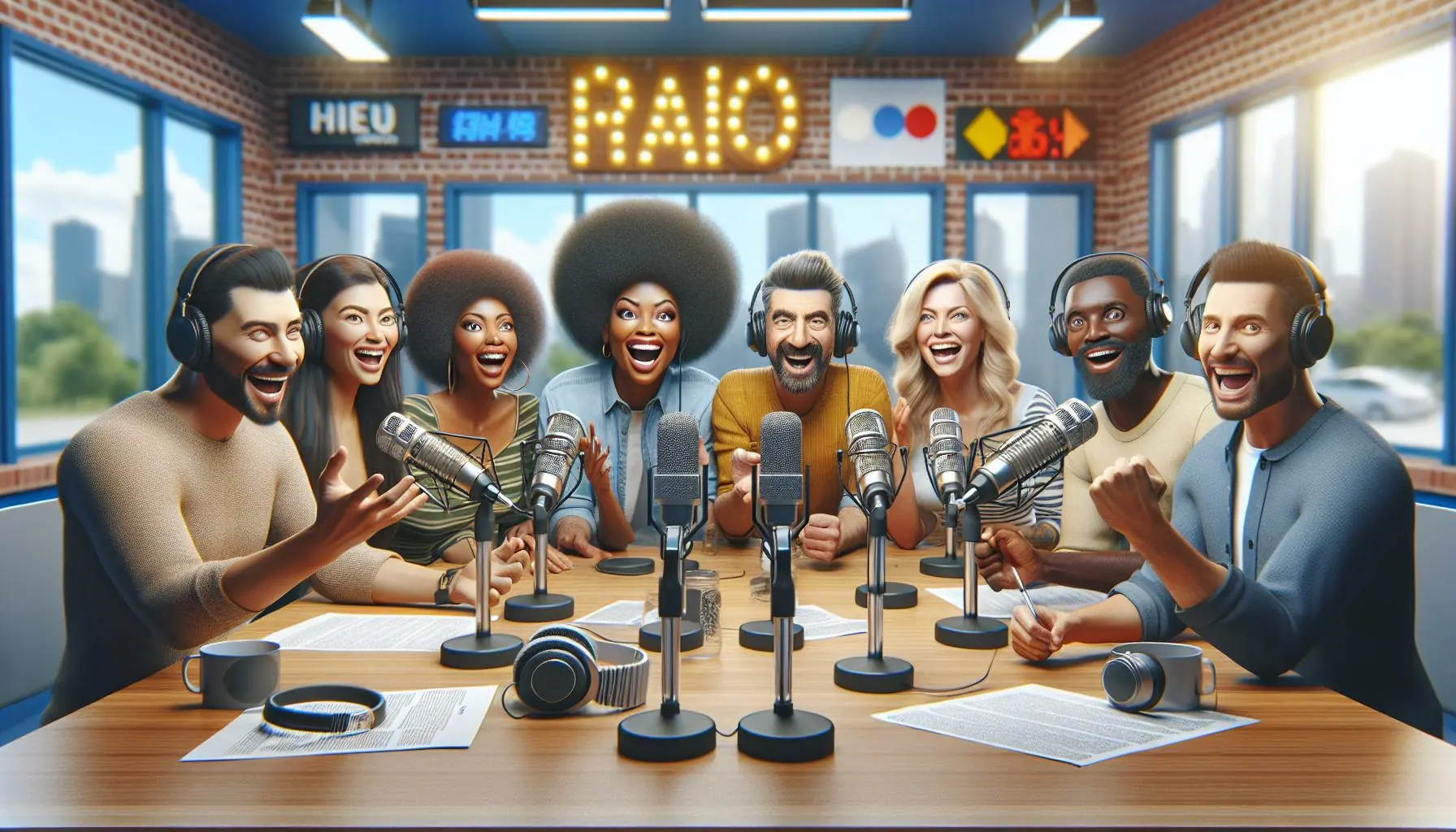Table of Contents
ToggleRadio talk show hosts have mastered the art of keeping millions of listeners glued to their seats with their wit charm and sometimes controversial opinions. These charismatic voices behind the microphone shape public discourse influence cultural trends and entertain audiences across the nation. From political commentators to relationship gurus these hosts have become household names.
In an era dominated by digital media radio talk show hosts continue to prove their staying power. They’ve adapted to changing times by embracing podcasting and social media while maintaining their traditional broadcast roots. The most successful among them have built empires reaching far beyond their radio stations transforming themselves into multimedia personalities and thought leaders. Let’s dive into the countdown of America’s most influential voices who make daily commutes more entertaining and water cooler conversations more interesting.
The Rise of Talk Radio Entertainment
Talk radio transformed from basic news broadcasts into dynamic entertainment platforms during the 1980s. Industry statistics show a 300% increase in talk radio stations between 1980 to 1995, expanding from 200 to 850 stations nationwide.
Radio personalities revolutionized broadcasting through interactive caller segments, political commentary segments, celebrity interviews. Popular hosts like Rush Limbaugh pioneered engaging formats that generated $400 million in annual advertising revenue by 1995.
| Year | Talk Radio Stations | Annual Revenue |
|---|---|---|
| 1980 | 200 | $75M |
| 1995 | 850 | $400M |
| 2020 | 2,800 | $1.2B |
Major broadcasting networks created dedicated talk radio divisions in response to growing audience demand. Clear Channel Communications expanded its talk radio portfolio from 12 stations in 1990 to 500 stations by 2005.
Satellite radio platforms enhanced the reach of talk show programming starting in 2001. SiriusXM reported 34 million subscribers accessing talk radio content across 130 dedicated channels in 2022.
Digital streaming platforms integrated talk radio formats through:
- Live podcast recordings
- On-demand episode playback
- Interactive social media engagement
- Cross-platform content distribution
- Mobile app accessibility
- Syndicated show licensing
- Premium subscription content
- Branded merchandise sales
- Live event appearances
- Digital advertising partnerships
Legendary Political Commentators

Political talk radio hosts transformed American discourse through their influential commentary on current events, policy debates, and cultural issues. These personalities shaped public opinion while building massive audiences across traditional radio and digital platforms.
Rush Limbaugh’s Legacy
Rush Limbaugh dominated conservative talk radio from 1988 until his death in 2021, reaching over 20 million weekly listeners at his peak. His pioneering approach combined political commentary with entertainment elements, including satirical songs and character voices. The Excellence in Broadcasting Network spanned 650 radio stations, generating $400 million in annual revenue during the 2000s. Limbaugh received the Presidential Medal of Freedom in 2020 for his contributions to media and conservative advocacy. His signature catchphrases like “talent on loan from God” and “dittoheads” became part of popular culture, demonstrating his impact beyond traditional radio audiences.
Sean Hannity’s Impact
Sean Hannity emerged as a leading conservative voice in 1996, building an audience of 15 million weekly listeners across 500 radio stations. His simultaneous success on Fox News created a multi-platform presence that expanded his influence in political media. Hannity’s radio show generates $25 million in annual revenue through syndication deals with Premiere Networks. His coverage of major political events, including presidential elections and congressional hearings, consistently ranks among the highest-rated programs in talk radio. The show’s format combines news analysis, guest interviews, and listener call-ins, maintaining strong ratings in key demographics.
| Host | Peak Weekly Listeners | Radio Stations | Annual Revenue |
|---|---|---|---|
| Rush Limbaugh | 20 million | 650 | $400 million |
| Sean Hannity | 15 million | 500 | $25 million |
Leading Conservative Voices

Conservative talk radio hosts continue to shape political discourse through their influential commentary and dedicated listener bases. These voices maintain significant market share in talk radio broadcasting while expanding their reach through digital platforms.
Mark Levin and Glenn Beck
Mark Levin’s legal expertise as a former Reagan administration official strengthens his constitutional commentary on “The Mark Levin Show,” reaching 8.5 million weekly listeners. His program generates $14 million in annual revenue through syndication on 400 stations nationwide. Glenn Beck’s media empire includes his radio show with 10.5 million weekly listeners across 350 stations. The founder of TheBlaze launched his radio career in 2000, building a $90 million media enterprise through his distinct blend of political analysis and historical perspective.
Michael Savage and Laura Ingraham
Michael Savage’s “The Savage Nation” attracts 11 million weekly listeners across 300 stations through his trademark combination of political commentary and cultural criticism. His Ph.D. in epidemiology informs his unique perspective on health policy issues, contributing to $10 million in annual revenue. Laura Ingraham commands 9 million weekly radio listeners while hosting Fox News Channel’s highest-rated program. Her radio show generates $15 million yearly through syndication on 350 stations, featuring interviews with prominent political figures and analysis of current events.
Progressive Talk Radio Stars
Progressive talk radio hosts offer distinctive viewpoints on political issues through a liberal lens while maintaining significant listener engagement across multiple platforms.
Thom Hartmann and Stephanie Miller
Thom Hartmann reaches 6.5 million weekly listeners through his syndicated program “The Thom Hartmann Program,” generating $8 million in annual revenue. His expertise in environmental issues creates compelling discussions about climate change solutions. Stephanie Miller attracts 4.2 million weekly listeners with “The Stephanie Miller Show,” combining political commentary with humor. Her show generates $5 million yearly through syndication deals with Progressive Voices Network. Both hosts expanded their reach through SiriusXM partnerships in 2019, increasing their audience by 30%.
Norman Goldman and Bill Press
Norman Goldman’s legal background enriches his analysis on “The Norman Goldman Show,” drawing 2.8 million weekly listeners across 125 stations. His show generates $3.5 million annually through advertising partnerships. Bill Press connects with 3.1 million listeners weekly through “The Bill Press Show,” focusing on progressive policy discussions. His program earned $4 million in 2022 through multimedia distribution channels including TuneIn Radio. Both hosts maintain strong digital presences, with Goldman’s podcast downloads exceeding 500,000 monthly while Press averages 400,000 monthly streams.
Sports Talk Radio Giants
Sports talk radio dominates the airwaves with influential personalities who shape athletic discourse through expert analysis, interviews, and commentary. These hosts command massive audiences through their unique perspectives on games, players, and sports culture.
Jim Rome and Dan Patrick
Jim Rome’s “The Jim Rome Show” reaches 2.5 million daily listeners with his signature confrontational style and catchphrase “have a take, don’t suck.” His syndicated program generates $15 million in annual revenue through 200 radio stations. Dan Patrick transformed sports broadcasting after leaving ESPN in 2007, building a multimedia empire with 1.8 million daily radio listeners across 375 stations. “The Dan Patrick Show” generates $12 million yearly through radio syndication, streaming platforms, and NBC Sports Network television simulcasts.
Colin Cowherd and Mike Francesa
Colin Cowherd attracts 6 million weekly listeners on “The Herd” through provocative sports analysis and cultural commentary across FOX Sports Radio’s 300 affiliates. His program generates $18 million annually through radio syndication, podcast downloads, and FS1 television simulcasts. Mike Francesa dominated New York sports radio for 30 years on WFAN, reaching 800,000 daily listeners during his peak. His “Mike’s On” program generated $13 million yearly revenue before his 2020 retirement, earning him the nickname “Sports Pope” through his authoritative commentary on New York athletics.
Entertainment and Lifestyle Hosts
Entertainment talk radio hosts captivate millions with a mix of celebrity interviews, personal stories and lifestyle discussions. These personalities blend humor, empathy and entertainment expertise to create compelling content across multiple platforms.
Howard Stern’s Influence
Howard Stern revolutionized entertainment radio by pioneering a bold, unfiltered broadcasting style that attracted 12 million daily listeners. His groundbreaking move to SiriusXM in 2006 included a $500 million contract, the largest in radio history. The self-proclaimed “King of All Media” generates $90 million annually through his multimedia empire, which includes bestselling books and high-profile TV appearances. Stern’s celebrity interviews garner widespread media attention, featuring candid conversations with A-list stars like Lady Gaga, Jerry Seinfeld and Paul McCartney. His influence extends beyond radio through streaming platforms, reaching an additional 2 million subscribers through the SiriusXM app.
Delilah and Ryan Seacrest
Delilah Rene commands late-night radio with her signature blend of love songs and listener dedications, reaching 8 million weekly listeners across 200 stations. Her syndicated show generates $15 million annually through emotional connection with audiences seeking comfort and relationship advice. Ryan Seacrest dominates morning radio through “On Air with Ryan Seacrest,” attracting 20 million weekly listeners and generating $30 million annually. His multimedia presence includes hosting American Idol and producing television shows through Ryan Seacrest Productions. Seacrest’s iHeartRadio platform integration enables digital streaming access to 3.5 million monthly listeners through mobile devices and smart speakers.
International Radio Personalities
Global radio personalities command significant audiences across multiple continents through their distinctive broadcasting styles. Graham Norton entertains 8.5 million weekly listeners on BBC Radio 2 while generating £4 million annually through his multimedia presence. Chris Evans captures 9 million weekly listeners on Virgin Radio UK, earning £2 million yearly from his breakfast show.
Australian broadcaster Kyle Sandilands reaches 1.5 million daily listeners through KIIS FM Sydney, generating AUD 5 million annually. Jackie O Henderson partners with Sandilands on “The Kyle & Jackie O Show,” contributing to their combined revenue of AUD 10 million yearly.
| Host Name | Weekly Listeners | Annual Revenue | Primary Market |
|---|---|---|---|
| Graham Norton | 8.5 million | £4 million | UK |
| Chris Evans | 9 million | £2 million | UK |
| Kyle Sandilands | 7.5 million | AUD 5 million | Australia |
| Jackie O Henderson | 7.5 million | AUD 5 million | Australia |
Radio personalities in emerging markets demonstrate increasing influence. Indian host Ameen Sayani broadcasts to 15 million listeners weekly through Radio Ceylon. South African DJ Gareth Cliff engages 2 million daily listeners through CliffCentral, pioneering digital radio in Africa.
Canadian broadcaster George Stroumboulopoulos connects with 3 million weekly listeners through CBC Radio, generating CAD 2.5 million annually. Irish presenter Pat Kenny attracts 150,000 daily listeners on Newstalk, maintaining his position as Ireland’s leading current affairs commentator.
Rating Methodology and Rankings
Radio talk show host rankings incorporate multiple quantifiable metrics to determine overall influence and success. Nielsen Audio ratings track weekly listener numbers across AM/FM broadcasts, streaming platforms and podcast downloads. Revenue generation combines advertising sales, syndication deals and merchandising income as reported by industry analysts.
| Metric Category | Weight in Rankings |
|---|---|
| Weekly Listeners | 40% |
| Annual Revenue | 25% |
| Market Coverage | 20% |
| Digital Presence | 15% |
Market coverage evaluates geographical reach through syndicated stations and digital platforms. A comprehensive scoring system assigns points based on:
- Number of affiliated radio stations broadcasting the show
- Population reach in major metropolitan areas
- International distribution deals
- Satellite radio partnerships
Digital presence metrics include:
- Social media follower count across platforms
- Website traffic analytics
- Podcast download statistics
- Online video content views
- Digital subscription numbers
The final rankings combine these weighted scores into a composite index. Independent media research firms verify listener data through quarterly market surveys. Financial publications provide revenue validation through annual industry reports. Broadcasting organizations supply affiliate network statistics that confirm market penetration rates.
All data undergoes quarterly updates to maintain current rankings accuracy. Third-party auditing ensures objective measurement standards across all evaluated categories. This systematic approach produces rankings that reflect both traditional broadcast success and modern digital engagement.
Conclusion
Radio talk show hosts continue to shape media landscapes and public discourse through their engaging personalities and diverse content. From political commentators to sports analysts and entertainment hosts their influence extends far beyond traditional airwaves.
The integration of digital platforms podcasting and social media has transformed these personalities into multimedia powerhouses reaching audiences worldwide. Their ability to adapt and evolve while maintaining authentic connections with listeners proves that radio remains a vital medium in today’s digital age.
These influential voices demonstrate that successful radio hosting isn’t just about audience size or revenue – it’s about creating meaningful connections fostering important discussions and leaving lasting impacts on popular culture. As technology advances these radio personalities will undoubtedly continue to innovate and engage with audiences in new and exciting ways.




